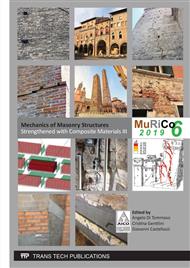[1]
T. C. Triantafillou, Strengthening of masonry structures using epoxy-bonded FRP laminates,, ASCE J. Compos. Constr., vol. 2, no. 2, p.96–104, May (1997).
DOI: 10.1061/(asce)1090-0268(1998)2:2(96)
Google Scholar
[2]
J. Tumialan and A. Nanni, In-plane and out-of-plane behavior of masonry walls – strengthened with FRP systems,, Rolla, (2001).
DOI: 10.1061/40492(2000)176
Google Scholar
[3]
ACI 440.7R-10 (2010), Guide for the design and construction of externally bonded fiber-reinforced polymer systems for strengthening unreinforced masonry structures. American Concrete Institute, (2010).
DOI: 10.14359/51663675
Google Scholar
[4]
CNR-DT 200 R1 (2013), Guide for the Design and Construction of Externally Bonded FRP Systems for Strengthening Existing Structures Materials, RC and PC structures, masonry structures, Italian Council of Research (CNR). Rome (Italy), (2013).
DOI: 10.1061/40753(171)159
Google Scholar
[5]
ACI 549.4R-13 (2013), Guide to design and construction of externally bonded fabric-reinforced cementitious matrix (FRCM) systems for repair and strengthening concrete and masonry structures. American Concrete Institute, (2013).
DOI: 10.1016/j.prostr.2018.11.027
Google Scholar
[6]
ACI 549-L Liaison Committee with RILEM TC 250-CSM (2018), Guide to Design and Construction of Externally Bonded Fabric Reinforced Cementitious Matrix (FRCM) and Steel Reinforced Grout (SRG) Systems for Repair and Strengthening Masonry Structures. Draft, (2018).
DOI: 10.14359/51702356
Google Scholar
[7]
CNR-DT 215 (2018), Guide for the Design and Construction of Fiber Reinforced Inorganic Matrix Systems for Strengthening Existing Structures, Italian Council of Research (CNR). Rome (Italy), (2018).
Google Scholar
[8]
Eurocode 6, Design of masonry structures. Part 1-1, General rules for buildings : rules for reinforced and unreinforced masonry (together with United Kingdom national application document). British Standards Institution, (1996).
DOI: 10.3403/00873617
Google Scholar
[9]
F. Parisi, G. P. Lignola, N. Augenti, A. Prota, and G. Manfredi, Nonlinear Behavior of a Masonry Subassemblage Before and After Strengthening with Inorganic Matrix-Grid Composites,, J. Compos. Constr., vol. 15, no. 5, p.821–832, Jan. (2011).
DOI: 10.1061/(asce)cc.1943-5614.0000203
Google Scholar
[10]
V. Giamundo, G. P. Lignola, G. Maddaloni, A. Balsamo, A. Prota, and G. Manfredi, Experimental investigation of the seismic performances of IMG reinforcement on curved masonry elements,, Compos. Part B Eng., vol. 70, p.53–63, (2015).
DOI: 10.1016/j.compositesb.2014.10.039
Google Scholar
[11]
V. Giamundo, G. P. Lignola, G. Maddaloni, F. da Porto, A. Prota, and G. Manfredi, Shaking table tests on a full-scale unreinforced and IMG-retrofitted clay brick masonry barrel vault,, Bull. Earthq. Eng., vol. 14, no. 6, p.1663–1693, Jun. (2016).
DOI: 10.1007/s10518-016-9886-7
Google Scholar
[12]
A. Garofano, F. Ceroni, and M. Pecce, Modelling of the in-plane behaviour of masonry walls strengthened with polymeric grids embedded in cementitious mortar layers,, Compos. Part B Eng., vol. 85, p.243–258, Feb. (2016).
DOI: 10.1016/j.compositesb.2015.09.005
Google Scholar
[13]
C. D'Ambra, G. P. Lignola, F. Fabbrocino, A. Prota, and E. Sacco, Repair of Clay Brick Walls for out of Plane Loads by Means of FRCM,, KEY Eng. Mater., p.358–365, (2017).
DOI: 10.4028/www.scientific.net/kem.747.358
Google Scholar
[14]
C. D'Ambra, G. P. Lignola, A. Prota, E. Sacco, and F. Fabbrocino, Experimental performance of FRCM retrofit on out-of-plane behaviour of clay brick walls,, Compos. Part B Eng., vol. 148, (2018).
DOI: 10.1016/j.compositesb.2018.04.062
Google Scholar
[15]
G. Lignola, C. D'Ambra, A. Prota, and F. Ceroni, Modelling of tuff masonry walls retrofitted with inorganic matrix–grid composites,, in Brick and Block Masonry, CRC Press, 2016, p.2127–2135.
DOI: 10.1201/b21889-263
Google Scholar
[16]
G. P. Lignola, A. Prota, and G. Manfredi, Nonlinear Analyses of Tuff Masonry Walls Strengthened with Cementitious Matrix-Grid Composites,, J. Compos. Constr., vol. 13, no. 4, p.243–251, Mar. (2009).
DOI: 10.1061/(asce)cc.1943-5614.0000007
Google Scholar
[17]
G. P. Lignola, A. Prota, and G. Manfredi, Numerical Investigation on the Influence of FRP Retrofit Layout and Geometry on the In-Plane Behavior of Masonry Walls,, J. Compos. Constr., vol. 16, no. 6, p.712–723, Dec. (2012).
DOI: 10.1061/(asce)cc.1943-5614.0000297
Google Scholar
[18]
Ö. S. T. B. T. De Vries and S. N. M. W. A. T. Vermeltfoort, In‑plane behaviour of clay brick masonry wallettes retrofitted with single‑sided fabric‑reinforced cementitious matrix and deep mounted carbon fibre strips, no. 0123456789. Springer Netherlands, (2019).
DOI: 10.1007/s10518-019-00596-2
Google Scholar
[19]
F. Parisi, G. Lignola, N. Augenti, A. Prota, and G. Manfredi, Rocking response assessment of in-plane laterally-loaded masonry walls with openings,, Eng. Struct., vol. 56, p.1234–1248, Nov. (2013).
DOI: 10.1016/j.engstruct.2013.06.041
Google Scholar
[20]
V. Giamundo, V. Sarhosis, G. P. Lignola, Y. Sheng, and G. Manfredi, Evaluation of different computational modelling strategies for the analysis of low strength masonry structures,, Eng. Struct., vol. 73, p.160–169, Aug. (2014).
DOI: 10.1016/j.engstruct.2014.05.007
Google Scholar
[21]
G. Ramaglia, F. Fabbrocino, G. P. Lignola and A. Prota Unified theory for flexural strengthening of masonry with composites,, Materials, vol. 12, no. 4, pp.1-26, (2019).
DOI: 10.3390/ma12040680
Google Scholar


